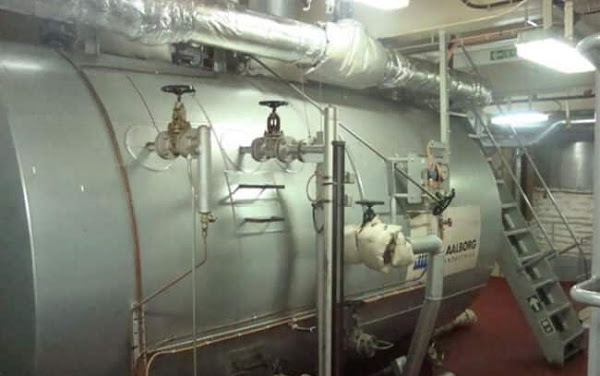#28 Important Points for Boiler Cleaning on a Ship
A boiler is among the essential machines onboard ships. It is mainly responsible for generating high-pressure steam for the main propulsion system and auxiliary machines. Thus boiler cleaning is required regularly to ensure the smooth functioning of the machine and other systems related to it onboard ships. Failing to clean boilers reduces their efficiency. Uncleaned boilers consume more energy and resources, and this may cause various problems on board ships; for example, the walls of boilers may corrode and cause hazards.
Boiler cleaning involves effacing undesirable deposits and pollutants on the inner walls, tubes and various surfaces of the boiler. It prevents carbon and particle deposits like calcium carbonate from entering the boilers.
It is one of the most critical operations to be regularly executed onboard ships. Some important points to be kept in mind while boiler cleaning on board a vessel are as follows:-
Steps before cleaning
- Freshwater should be used to operate the boilers instead of heavy water to minimize the particle deposit inside the tubes.
- Deposit Weight Density should be used to determine when to clean the boilers.
- Plastics should be used to cover the refractories so that they don’t get wet, or else instant cooling and heating, on lighting the burner might crack the refractory, damaging the equipment.
- The boiler oil burner should be regularly checked, and proper maintenance should be carried out occasionally to minimize the soot deposits inside the oil-fired boiler.
- Before chemical cleaning, ensure the boiler water is adequately treated with chemicals.
Chemicals or compounds used in cleaning boilers
- Alkaline like soda ash, caustic soda, phosphates, complex phosphate, and silicates.
- Acids like hydrochloric acid, sulfamic acid, formic acid, hydrofluoric acid, phosphoric acid, ammoniated citric acid, ethylenediaminetetraacetic acid (EDTA), hydroxyacetic acid.
Boiler Cleaning: Important Points to keep in mind
- Suppose the boiler water is adequately treated with chemicals and the concentration of chemicals is within the acceptable range. In that case, the deposits on the walls of the water and the steam side of the boiler will be minimal.
- If the boiler operates on freshwater rather than heavy water, the deposits inside the tubes will also be minimal and can be removed by boiling out. The hard deposits inside the tubes are removed with the help of a scrubber and brush from the upper drum.
- If the boiler oil burner is functioning properly and proper maintenance is being carried out from time to time, then the soot deposits inside the oil-fired boiler will be minimal. But the soot deposits cannot be avoided entirely. In the beginning, excessive soot is formed; however, over a while, it collects inside the boiler space.
- The soot deposits can be removed with the help of water washing with a 10 per cent soda solution through the inlet door in the uptake with the help of a water hose.
Necessary precautions during water washing.
- Care should be taken so that the refractory inside the boiler does not get wet.
- During water washing, the refractory should be covered with the plastic sheet, and water should be drained off continuously through the drain provided at the bottom.
- If the refractory gets wet, the boiler should be lighted gradually; otherwise, the refractory will crack and drop down, leading to overheating and deformation.
- The chemical cleaning solvent must be entirely drained from the unit just after cleaning.
- There may be remnants of iron oxides in the boiler after the cleaning, which can lead to “black water” samples and high iron levels in the boilers. The boiler dispersants should be used for a time to assist in the suspension and elimination of any residual deposits through the standard drum blowdown.
Tools used for boiler cleaning
- Boiler Tube Beveling Tools These apparatuses are Portable Pipe Cutting Machines for in-situ accuracy cutting and slanting all line sizes, timetables, and materials.
- Rolling Motors and Tube Expanders These instruments are utilized for manufacturing and keeping up with boilers, heat exchangers, and condensers.
- Boiler Tube Cutting Saws These devices give perfect, precise, straight cuts with no”HAZ” (Heat Affect Zone) while cutting boiler tube boards.
- Boiler Tube Alignment Clamps These apparatuses speed the welding system for heater tube waterwall board substitution by rapidly and precisely adjusting new evaporator tube closes with existing cylinders in anticipation of making welded tube joints.
- Soot buster These devices are lightweight and simple to utilize. They likewise lessen the time expected to clean a firetube heater or oil field drill pipe.
- Roto-jet Roto-Jet is a powerful answer for increment chiller, condenser, and other intensity exchanger proficiency. Split Away Coupling Innovative coupling broadens the shaft life by shielding it from a devastating break.
- Turbine style cleaner Turbine Style Tube Cleaners eliminate the hardest impurities, including unshakable scale.
Side effects of boiler cleaning.
- Chemical cleaning of boilers might be dangerous. If left unchecked, the chemical solution may find its way to the superheater, causing failure.
- Acid cleaning should be routinely monitored. Otherwise, it may cause hydrogen embrittlement, hydrogen gas explosion, and corrosion.
- While chemical cleaning, long-term exposure to hazardous chemicals may lead to various respiratory problems like asthma and Chronic obstructive pulmonary disease (COPD). Hence, it is essential to wear safety equipment.
Precautions.
- The topmost priority before cleaning is to isolate the boiler first.
- Proper Personal Protective Equipment (PPE) should be used while cleaning the boilers.
- Chemicals for cleaning should be handled with care, or else mishandling may result in accidents.
- Goggles and masks are mandatory while cleaning the boiler to avoid breathing problems and harm to our eyes.
- Ensure that the blowdown of all boilers in the battery is not connected.



Comments
Post a Comment